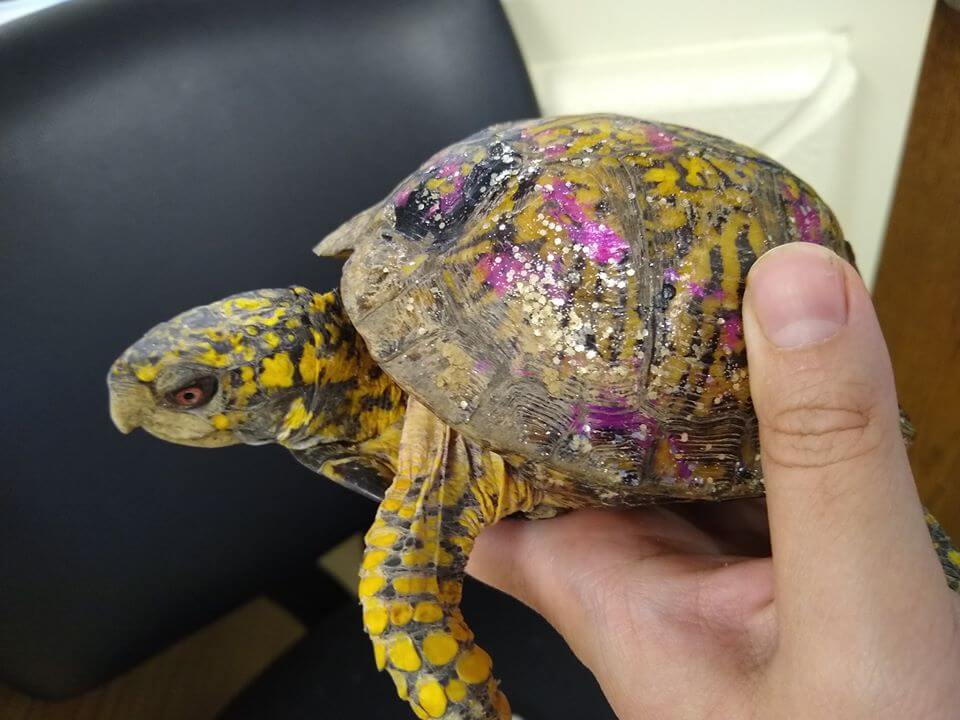Never Paint a Turtle’s Shell: When “Art” Becomes Cruelty

Across social media platforms and in backyard ponds, a troubling trend has emerged: well-meaning pet owners and enthusiastic decorators “customizing” turtle shells with bright paints, markers, or nail polish. Yet what may look like harmless decoration is, in reality, a silent form of animal abuse—one that can cripple a turtle’s health, well-being, and very survival.
The Living Shell
A turtle’s shell is far more than a hard exterior. It is living tissue, richly supplied with nerves, blood vessels, and specialized cells that regulate body temperature and facilitate respiration. Through microscopic pores in its scutes (the individual plates on the shell), a turtle absorbs ultraviolet (UV) light—vital for synthesizing vitamin D₃, metabolizing calcium, and maintaining strong bones.
“When you coat a turtle’s shell with paint, you create a barrier that blocks UV light and air exchange,” explains Dr. Maria Santos, a reptile veterinarian at the Wildlife Health Center. “This disruption leads to metabolic bone disease, infections, and, ultimately, a slow, painful death.”
The Hidden Dangers of “Colorful” Coats
-
Blocked UV Absorption
-
Without direct UV exposure, turtles cannot produce enough vitamin D₃. Calcium deficiencies set in, resulting in softening of the shell (known as “rubber shell”) and skeletal deformities.
-
-
Impaired Thermoregulation
-
Turtles rely on their shells to absorb heat from sunlight. Opaque paints alter shell temperature dynamics, hampering digestion, immune response, and overall activity levels.
-
-
Trapped Pathogens
-
The shell’s natural ability to slough off algae, bacteria, and fungi is inhibited by layers of paint or nail polish. Moisture and contaminants become trapped, often leading to painful shell rot or systemic infections.
-
-
Toxic Chemicals
-
Many household paints and nail polishes contain heavy metals, solvents, and other toxins. Over time, these chemicals leach through the shell’s porous surface into the turtle’s bloodstream.
-

A Global Problem
Rescue organizations worldwide report seizing thousands of painted turtles each year. In one study conducted by the Turtle Conservation Trust, 42% of rehabilitated box turtles showed signs of shell damage directly attributable to decorative painting. Many cases go undetected—animals simply fade away, their suffering unseen and unspoken.
“It’s not art,” stresses Janet Liu of the Reptile Rescue Alliance. “It’s animal cruelty hidden behind hashtags and Instagram filters.”
A Call to Action
-
Educate & Advocate. Turtle owners, pet shop employees, and wildlife enthusiasts must spread awareness: a turtle’s shell is not a canvas.
-
Report & Rescue. If you encounter a painted turtle, contact your local wildlife rehabilitator or veterinarian immediately. Many injuries can be treated if caught early.
-
Support Legislation. Several states and countries have already banned or restricted the sale of turtle-painting kits. Push for stricter animal welfare regulations in your community.

Conclusion
Behind every painted shell is a creature robbed of its natural defenses, battling disease without the tools nature designed. True appreciation of turtles lies in protecting their health and habitat—allowing their shells to remain the elegant, living armor they were meant to be.
Never paint a turtle’s shell. In doing so, we ensure these ancient mariners of freshwater and land can thrive—unadorned, unburdened, and free.












